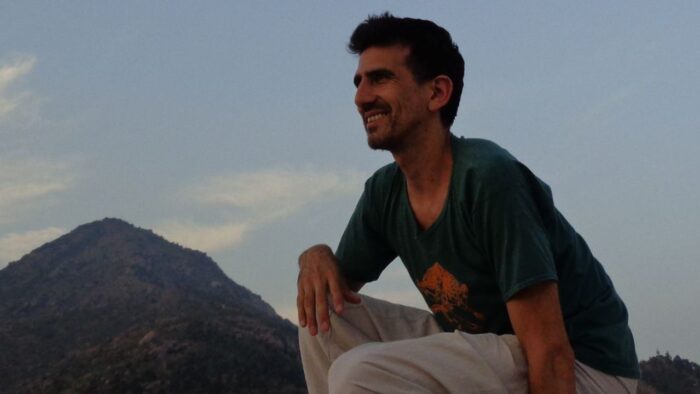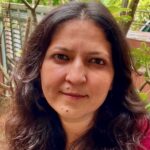Said Camilo Dattoli when I asked him what advice he would give to young yoga students who want to start teaching. This was among the best advice I’ve heard from a yoga teacher and practitioner about the intention of teaching. “Have you ever wondered why you want to teach? Ask yourself that now and continue to do so over the years. Revalidate your answer, reformulate it, recreate it, lose it.” Indica Yoga is in conversation with the Chile-based yoga teacher, vedic chanter and artist.
Sophia: How did your spiritual journey begin and how did you find the Yoga practice?
Camilo: Today, close to 50, I look back and think that my spiritual path, and every human being’s begins at birth. All the circumstances of this incarnation are a fundamental part and not at all casual — my first Gurus, my father and mother who transmitted to me the love and value of freedom and my confused adolescence taught me to expand the limits and brought me closer to art. I could not say that my spiritual path began with yoga, it would be unfair to all the teachings received before finding it. However, yoga is the tool that appears at the right time when it requires a systematic process of cleansing and serenity. In my late 20s, I knew that the time to change my rhythm and way of life was coming. After studying the arts and some years of cinema studies, I was tired of the bohemian style of life and a friend at film school prescribed yoga classes. My approach to the books of beatniks like Allen Ginsberg and the music of George Harrison and Ravi Shankar gave me a fantastic idea about what yoga could be. The progressive clarity that yoga brings gives me some self-esteem and that transforms everything; my diet, my likes and the simplest habits. The most fantastic thing is that this continues to happen to this day.
Sophia: What does India mean to you?
Camilo: India is the land of the greatest mysteries. To travel its vast territory is to navigate the map of the Being. The more you explore, the more you discover, the more you learn. It is the Eternal source. As we delved into the TTC of vedic chanting with Shantala Sriramaiah (Veda Studies) I kept receiving new inspiration and information that India, as living knowledge, has to give to humanity. That happened to me every time I was in India, with great teachers, with common people and with the landscape also. Walking the streets of Kashi (Varanasi) can be very revealing.
Sophia: Tell us about your experience with learning Vedic chanting and how has chanting added to your spiritual progress?
Camilo: When I first heard authentic vedic chanting, it was magic. It captured me and I felt the need to join that group of pundits in their recitation. My first meeting with chanting, other than in yoga classes where mantras or slokas were chanted but not the way I heard it from the brahmins, was in the city of Mysore with the great teacher Dr. M.A. Jayashree in 2013. That is my favourite place in Mysore — that small room full of books where different texts were chanted. Those valuable teachers nurtured my path and also relevant is Andres Wormull, who showed me that yoga asanas and vedas go very well together. Finding my current teacher was a gift that I know the practice brought me. Shantala Sriramaiah is the one who today brings me closer to that magic that I felt the first time I heard the Ramana Ashram Pandits sing the Rudram. Learning Vedic chanting has been a great challenge full of beauty. After many years of yogasanas, the recitation came to refine my nervous system giving me more clarity, equanimity and internal strength. Vedic chanting turned my yoga practice into a sadhana and sadhana is the lifeboat in this Samsara.
Sophia: How do you maintain authenticity to the Indian roots of yoga as a western practitioner and teacher?
Camilo: I believe that being a Western practitioner or teacher is not an obstacle to respectfully following the traditions and teachings of Yoga. I think the global economic system is. In any part of the world, if your objective is to sell your product, you will put the authenticity of its roots at risk.
I follow these principles: First, maintain the connection with the territory. Experience the space-time of the place of origin. I try to travel to India as much as I can. Second, to maintain the link with the teachings of India in a direct way, with teachers who follow a traditional lineage. Nurture your practice and teaching directly from the source. And third and most important, be humble
Sophia: Which spiritual masters’ life and work inspire you?
Camilo: Ramana Maharshi inspires me and teaches me. When I visit his ashram in Arunachalam, I can feel his presence, his gaze inviting me to sit down and stop. When my relationship with reality becomes complex, just seeing the title of a book responds: Be As You Are. The clarity of the teacher simplifies the practice.
Sophia: What would be your advice to young yoga students who want to teach yoga?
Camilo: If one is a yoga student, there will be a certain rush to be a teacher, it denotes a rather modern category of yoga in times of capitalism. The student must recover the investment in his studies as soon as possible and he professionalises with a 500-hour TTC and hires a web designer and a social network administrator, he becomes a company. Being a yoga teacher is simple, purpose is required. If you are a dedicated practitioner and have a teacher, then you are on the way. It is all you need. But, have you ever wondered why you want to teach? Ask yourself that now and continue to do so over the years. Revalidate your answer, reformulate it, recreate it, lose it.
Sophia: What are your favourite books on spirituality?
Camilo: The Prophet by Kahlil Gibran — it is a very fundamental guideline about what is important in life, how to live and even how you teach or transmit.
The Autobiography of a Yogi by Paramahansa Yogananda showed me that the fantastic world of yogis was something real and possible. The Tibetan Book of the Dead by Evans Wentz It’s a great manual to die, to face demons and to become a compassionate being and much more.





